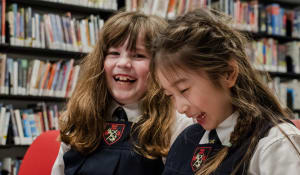Many new schools, especially those founded in the mid- to late-20th century, have been coed since their inception. Likewise, many older schools that started as boys’ schools began admitting girls. For example, St. John’s–Ravenscourt School began admitting girls in 1971, Ashbury College in 1982, and Appleby College in 1991.
Most importantly, schools adapted their programs to meet specific the needs of students. Single-gender schools aim to meet the needs not just of boys and girls, but of specific kinds of boys and girls. Today, the choice to attend one of these schools is less about gender, and more about about meeting the needs of specific types of students.
Coed schools
Schools that have both boys and girls are the norm in public schools. Most private schools are coed as well. Having both boys and girls creates a unique academic and social environment. It also reflects the world students encounter as adults.
Girls' schools
Available in much of Canada and at all ages, all-girls schools are still popular with parents who want their daughters to develop a strong sense of self and grow into mature women.
One of the oldest independent girls’ schools in Canada is Bishop Strachan School in Toronto. It was founded in 1867. The school has always been led by women who were strong and enthusiastic educators.
Anne Thomson was principal of the school in the 1870s. At the end of one year year, she addressed the students, saying:
“Remember girls, you are not going home to be selfish butterflies of fashion. The Bishop Strachan School has been endeavoring to fit you to become useful and courageous women. I believe you will yet see our universities open to women. Work out your freedom, girls! Knowledge is now no more a fountain sealed; drink deep!”
Through this kind of leadership girls’ schools established themselves. They were quietly—and at times not so quietly—empowering girls to do more and demand more from society.
While society has changed, for many girls, a single-gender school can still be very beneficial. Studies by the National Association for Choice in Education (NACE), and other studies, have shown that girls in single-sex environments are more likely to pursue interests in science and technology and take part in a wider range of extracurricular activities.
Boys' schools
Especially in the lower grades, boys’ schools have lots of physical pursuits. Boys are given more chances to be active than in a coed school. They also tend to do lots of learning by doing—touching and engaging rather than sitting and listening.
As Tom Stevens, director of admissions at Royal St. George’s College, a Toronto-based all-boys school, says: “In most schools, if you can sit quietly, hands folded, focused, you’ll do well. That doesn’t work for most boys.”
As boys get older, they are given more time to explore their unique interests—for example, in the arts. They aren't pigeon-holed or pushed to pursue traditional male activities, such as sports.
Boys’ schools aim to impart a passion for learning and the pursuit of academic excellence. The curriculum is often tailored to meet boys' academic and physical needs. There is also a focus on meeting developmental milestones.
Benefits of single-sex vs. coed schools
|
Common arguments for single sex
|
Common arguments for coed
|
Pedagogical arguments
|
- School can better tailor lessons and curriculum to students.
- It’s hard to be all things to all people. Boys and girls learn differently and single-sex schools are able to accommodate these differences without compromise. Many of the supposed differences in ability between boys and girls result from subjects not being taught to their respective learning style.
- In the areas boys and girls often do well in—whether it's in an intellectual, physical, or behavioural domain—they aren’t held back by the other gender. In areas they might struggle in, they aren’t overshadowed by the other gender or boxed into narrow gender stereotypes.
|
- The differences between boys’ and girls’ learning styles are overstated.
- Research shows that for up to 80% of students—both boys and girls—their brains are similar enough that they respond to the same teaching style.
- Academics are enriched when boys and girls are exposed to each other’s thinking and experiences in the classroom.
- Having boys and girls in the classroom creates balance, which benefits both. Where boys excel, they raise the standard for girls, and vice versa. Diversity allows students to stretch and challenge each other.
|
Developmental arguments
|
- Students are less fettered in developing their unique selves.
- In adolescence, kids can be more themselves without sexual competition.
- Kids can try different things
and explore unique interests and skills without the influence of social expectations stemming from gender roles.
- Without the distraction of mating rituals, students tend to be more focused on academics and extracurriculars—areas that pay higher dividends later in life. Kids don’t have to put being cool before learning.
- Cohorts tend to form more naturally without adolescent concerns about cliques and social status. The camaraderie that develops can be special.
- Going to a single-sex school doesn’t preclude students from interacting with the opposite sex, whether through extracurriculars or outside of school. By the time kids go out into the world of relationships, they are strong and fully formed individuals.
|
- Students have more opportunity to develop their social selves.
- As Aristotle said, humans are social animals. Today that means living in a coed world. Single-sex schools artificially shelter kids from this reality.
- Students learn to be tolerant of people who are different than them and to treat each other with respect. Students are exposed to both male and female role models.
- Especially in the older grades, many students prize their friendships with the other sex. This can take students out of their comfort zones and make them see the world differently.
- School and work aside, coed schools offer students more chances to build comfort talking and interacting with the other sex.
|





















